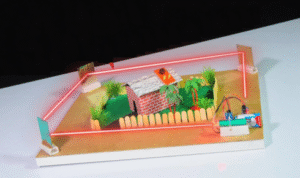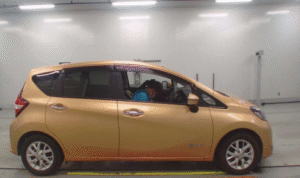1. What are robots and how do they work?
Definition: Robots are basically machines which can work on its own or semi-autonomous basis. They are engineered using sensors, actuators and algorithms to study and interact with the surroundings, complete tasks, and make decisions.
2. How are robots used today?
Answer: Robots are used in industries such as manufacturing, healthcare, agriculture, logistics, and entertainment. They assist in tasks like assembly, surgery, cleaning, delivery, and even companionship.
3. What types of robots will be common in daily life in the future?
Answer: In the future, we can expect robots like service robots (for cleaning, cooking, and maintenance), personal assistant robots, healthcare robots, delivery robots, and autonomous vehicles to become more common.
4. How do robots affect employment?
Answer: Robots can substitute some jobs, which are routine and physical in nature, but they will also introduce new job opportunities in robotics engineering, programming, and servicing. The workforce would have to evolve with new skills and training.
5. What are the advantages of robots in everyday life?
Answer: Robots will increase efficiency, reduce human labor in dangerous or repetitive tasks, improve accuracy, help healthcare, and upgrade the quality of life by handling mundane chores.
6. What kind of work will robots do at home?
Answer: Household robots may perform a variety of functions such as cleaning, cooking, organizing, caring for elderly people, controlling security systems at home, and providing companionship.
7. How will robots impact healthcare?
Answer: Robots will be involved in surgeries, administering medications, patient monitoring, keeping elderly company, and telemedicine services. They will be involved in rehabilitation and physical therapy.
8. What role will AI play in future robotics?
Answer: AI will help robots improve decision-making capabilities, adapt to new environments, learn from experience, and execute complex tasks. They will enhance autonomy and allow robots to better communicate with humans.
9. Can robots learn from humans?
Answer: Yes, robots equipped with AI and machine learning algorithms can learn from humans by observing actions, receiving feedback, and adapting their behavior accordingly to perform tasks more efficiently.
10. What ethical challenges will arise with robots in daily life?
Answer: Ethical issues will include privacy, autonomy in decision making, displacement of jobs, safety, and avoiding the robots’ harm to human beings. The right regulation and guidance will be needed.
11. How will the robots of the future be powered?
Answer: Advanced batteries, wireless energy, and perhaps even sustainable sources such as solar energy will be the future powering systems for robots. Research on efficiency will be essential in order to make robots more autonomous.
12. What will be the role of robots in transportation?
Robotics in transport will involve self-driving cars, delivery drones, and autonomous buses. These systems will make transport safer, more efficient, and decrease congestion.
13. How will robots help address the challenges with aging populations?
Robots will assist elderly people by providing mobility assistance, monitoring health, reminding them to take their medication, offering companionship, and helping with daily activities like cooking and cleaning.
14. Will robots replace human caregivers?
Answer: Robots can be helpful in the work of caregivers, doing some of the jobs for them. However, there will always be a need for human caregivers, who will continue to provide the emotional support and make decisions required in complex care situations.
15. How will robots change education?
Answer: Robots could serve as personalized tutors, assist in STEM education, and provide hands-on learning experiences. They could also help teach new skills in robotics and AI to students of all ages.
16. Which future industries will experience the most robot benefits?
Industries expected to benefit hugely from robotics, through increased efficiency, safety and customer service benefits, include; healthcare, logistics, manufacturing, agriculture, hospitality, and entertainment.
17. How will people interact with a robot?
Answer: Robots will employ voice and facial recognition, gestures, and touch to interact with humans. They will become more intuitive and responding to emotional cues, and therefore, enabling more organic flow of communication.
18. What are the limitations of current robots?
Answer: Current robots are limited as they require detailed instructions, have no creativity, are unable to adapt to very complex dynamic environments, and have difficulties fine motor skills and emotional understanding.
19. Will robots be able to express emotions?
Answer: In the future, robots could be designed to simulate emotional responses by recognizing human emotions and adjusting their behavior accordingly. However, true emotional experience in robots is unlikely in the near future.
20. What are the safety concerns with robots?
Answer: Safety concerns will include robots malfunctioning, which can cause harm, or hacked. The concerns are also over dangerous decisions robots will make in a critical situation. Safety protocols and regulations will have to be strictly implemented.
21. Will the robots be able to drive cars in the future?
Answer: Yes, self-driving cars powered by AI and robotics are already in the making. They will be used to sense roads and cameras and other means of navigation through AI.
22. What is robot ethics, and why is it important?
Answer: Ethics of robot refer to the norms on the developing and using the robots safety, fairness, accountability, and respect for human rights. It is meant to have robots developed and used responsibly and ethically.
23. How will robots change the way we shop?
Answer: Robots would be able to assist in stores by managing the inventory, helping the customers locate products, and even possibly delivering the goods directly to the customer via autonomous delivery systems to increase convenience and efficiency.
24. What are collaborative robots (cobots)?
Answer: Collaborative robots, or cobots, are designed to work alongside humans in a shared environment. They can assist in tasks that require precision, strength, or repetitive motion while ensuring safety for human workers.
25. Will robots improve security in homes and workplaces?
Answer: Yes, robots will improve security, for instance, by surveying spaces, discovering intruders, and even responding to emergencies. Drones, autonomous security robots, and smart surveillance systems will be used in homes and businesses.
26. How will robots assist with environmental sustainability?
Answer: Robots can aid in recycling, cleaning the oceans, planting trees, and optimizing energy use. By doing such activities better, robots would reduce wasting a lot more and decrease environmental damage.
27. What is in the future for robotics in entertainment?
Answer: Eventually, robots will be more and more relevant in the entertainment sphere as performers, content creators, or virtual reality assistants. They can also be part of an interactive theme park experience or simply be a faithful entertainment companion.
28. Will robots be used in space exploration?
Answer: Yes, there have been robots used in space exploration from long ago up to the rovers which NASA sent to Mars; now in the future, they will help in space mining, conducting repairs, and even building other structures on other planets.
29. How will robots impact personal privacy?
Answer: Robots that collect personal data, like home assistants or robots with cameras, could raise privacy concerns. Ensuring that robots respect privacy, store data securely, and offer transparency will be critical in the future.
30. Will robots become an integral part of our daily routines?
Answer: Yes, robots are integrated into people’s daily lives, assisting in affairs, increasing efficiency, and providing convenience in such sectors as health, a household, and entertainment.
31. How will robots take on multi-tasking in the future?
Answer: Future robots will multi-task by advanced technology of AI, which will be able to process large volumes of data and adapt to new information. They will be more efficient at handling many tasks at once.
32. Can robots decide ethically?
Response: Though robots may be programmed according to the codes of ethics, they would never really understand it. They’ll decide on an algorithm and by the parameters designed by their inventors.
33. How do robots cope up with various cultures and surroundings?
Answer: With AI and machine learning, robots are going to be more adaptable as they will adapt to different environments, know cultural norms, and work with various human groups in effective ways.
34. Will robotics lead to a digital divide?
Answer: Robotics may lead to digital division if it reduces or limits access for all. To avoid the same, there would be a great need to ensure that the entire field of robotics has access to technology equitably.
35. What is the role of robots in disaster relief?
Answer: Robots can be used in disaster relief to look for survivors, deliver supplies, and evaluate damage. They can operate in dangerous conditions where it would be too hazardous for humans to do.
36. How will robots aid in mental health care?
Answer: Robots may provide companionship, monitor emotional well-being, and assist with therapeutic exercises. They can also deliver mental health services remotely, providing support in areas with limited access to care.
37. How will robots help with food production?
Answer: Robots will revolutionize food production by automating tasks like planting, harvesting, packaging, and even cooking. This will increase efficiency, reduce food waste, and support sustainable farming practices.
38. Will robots become better at doing things?
Answer: With machine learning, the robots will improve their performance with time by learning from their environment, adapting to changes, and enhancing their decision-making abilities over time.
39. What is the future for robots in the military?
Answer: Robots in the military can be applied for surveillance, bomb disposal, search and rescue operations, and autonomous combat systems. Ethical use in warfare, therefore, demands careful regulation.
40. What are the social implications of robots in society?
Answer: Social implications are changes in the nature of human relationships, job replacement, regulation, and that robots must enhance rather than complement human interaction and further improve the well-being of society.
41. How can robots help in the global aging crisis?
Answer: Robots can help address the aging crisis by providing assistance with daily activities, monitoring health, and reducing the strain on human caregivers, improving the quality of life for elderly people.
42. Will robots ever develop their own consciousness?
Answer: Robots with consciousness or self-awareness are still far from the current technology. Although robots may become very autonomous, the true consciousness remains a far-fetched goal and perhaps not attainable.
43. Can robots understand human emotions?
Answer: Robots will recognize and respond to human emotions with AI and facial recognition, but they will not feel emotions themselves. They will simulate empathy in order to make interactions with humans better.
44. What is the role of regulations in future robotics?
Answer: Regulations will be important to ensure that robots are safe, ethical, and protect human rights. They will govern robot design, deployment, and usage, and address issues like privacy, job displacement, and safety standards.
45. How will robots impact human creativity?
Answer: They can help to create art, music, and graphics. They present new tools that artists can employ. However, the human component of creativity-artistic emotion, intuition-will still be very necessary for original creations.
46. What are “social robots”?
Answer: Social robots are to be used by humans in the social context; they can serve as companions, caregivers, or educators, and they understand and respond to human emotions to be used for healthcare, education, and entertainment.
47. Can robots offer tailored experiences?
Answer: Robots with AI can personalize their service according to each person’s individual preferences, needs, and behavior, and allow for unique experience in shopping, health care, or entertainment.
48. How would robots handle human-robot collaboration?
Answer: Robots will partner with humans when they do all the hard labor or repetitive works while the humans make decisions or oversee. Efficiency and safety of industries will enhance.
49. How will robots change over the next ten years?
Answer: Over the next ten years, robots will be more autonomous, intelligent, and adaptive. They will seamlessly integrate into everyday life, improve their capabilities, and offer more sophisticated services across sectors.
50. What does the future hold for robotics in daily life?
Answer: The future of robotics in daily life is promising, with robots becoming integral in healthcare, household chores, transportation, and entertainment. They will enhance productivity, improve safety, and transform the way we interact with technology.








